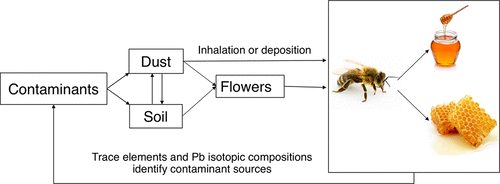当前位置:
X-MOL 学术
›
Environ. Sci. Technol.
›
论文详情
Our official English website, www.x-mol.net, welcomes your feedback! (Note: you will need to create a separate account there.)
Identifying Sources of Environmental Contamination in European Honey Bees (Apis mellifera) Using Trace Elements and Lead Isotopic Compositions
Environmental Science & Technology ( IF 11.4 ) Pub Date : 2018-01-09 00:00:00 , DOI: 10.1021/acs.est.7b04084 Xiaoteng Zhou , Mark Patrick Taylor , Peter J. Davies , Shiva Prasad 1
Environmental Science & Technology ( IF 11.4 ) Pub Date : 2018-01-09 00:00:00 , DOI: 10.1021/acs.est.7b04084 Xiaoteng Zhou , Mark Patrick Taylor , Peter J. Davies , Shiva Prasad 1
Affiliation

|
Trace element concentrations (As, Mn, Pb, and Zn) and Pb isotopic compositions were analyzed in honey bees, wax, and honey along with co-located soil and dust samples from Sydney metropolitan and Broken Hill, Australia. Compared with the other trace elements, Pearson correlations show that Pb concentrations in soil and dust had the strongest relationship to corresponding values in honey bees and their products. Dust Pb was not only highly correlated to corresponding soil values (r = 0.806, p = 0.005), it was the strongest predictor of Pb concentrations in honey bees, wax, and honey (p = 0.001, 0.007, 0.017, respectively). Lead isotopic compositions (206Pb/207Pb and 208Pb/207Pb) showed that honey bees and their products from Broken Hill were nearly identical (95–98%) to the composition of the local ore body. Samples of honey bees and their products collected from background sites adjacent to national parks in Sydney had Pb isotopic compositions (206Pb/207Pb = 1.138–1.159, 208Pb/207Pb = 2.417–2.435) corresponding to local geogenic values (206Pb/207Pb = 1.123–1.176, 208Pb/207Pb = 2.413–2.500). By contrast, honey bees and their products from Sydney metropolitan (206Pb/207Pb = 1.081–1.126, 208Pb/207Pb = 2.352–2.408) were similar to aerosols measured during the period of leaded petrol use (206Pb/207Pb = 1.067–1.148, 208Pb/207Pb = 2.341–2.410). These measurements show Pb concentrations and its isotopic compositions of honey bees, and their products can be used to trace both legacy and contemporary environmental contamination, particularly where sources are well documented. Moreover, this study demonstrates that legacy Pb emissions continue to be remobilized in dust, contaminating both food and ecological systems.
中文翻译:

利用微量元素和铅同位素组成鉴定欧洲蜜蜂(Apis mellifera)的环境污染来源。
分析了蜜蜂,蜡和蜂蜜中的痕量元素浓度(As,Mn,Pb和Zn)和Pb同位素组成,以及来自悉尼大都会和澳大利亚Broken Hill的同地土壤和粉尘样品。与其他微量元素相比,Pearson相关性表明,土壤和灰尘中的Pb浓度与蜜蜂及其产品中的相应值之间的关系最大。尘埃Pb不仅与相应的土壤值高度相关(r = 0.806,p = 0.005),也是蜜蜂,蜡和蜂蜜中Pb浓度的最强预测因子(分别为p = 0.001、0.007、0.017)。铅同位素组成(206 Pb / 207 Pb和208 Pb /207 Pb)表明,Broken Hill的蜜蜂及其产品与当地矿体的成分几乎相同(95-98%)。从邻近于悉尼国家公园背景地点收集蜜蜂的样品和它们的产品有铅同位素组成(206 PB / 207 PB = 1.138-1.159,208的Pb / 207 PB = 2.417-2.435),对应于本地环境地球化学值(206铅/ 207 PB = 1.123-1.176,208的Pb / 207 PB = 2.413-2.500)。相比之下,蜜蜂及其产品从悉尼市区(206 PB / 207 PB = 1.081-1.126,208 PB / 207PB = 2.352-2.408)类似于期间含铅汽油使用(的时间段内测量气溶胶206的Pb / 207 PB = 1.067-1.148,208的Pb / 207 PB = 2.341-2.410)。这些测量结果显示了蜜蜂的Pb浓度及其同位素组成,其产品可用于追溯遗留和当代环境污染,尤其是在有充分文献记录的地方。此外,这项研究表明,旧有的Pb排放物仍在灰尘中迁移,污染了食物和生态系统。
更新日期:2018-01-10
中文翻译:

利用微量元素和铅同位素组成鉴定欧洲蜜蜂(Apis mellifera)的环境污染来源。
分析了蜜蜂,蜡和蜂蜜中的痕量元素浓度(As,Mn,Pb和Zn)和Pb同位素组成,以及来自悉尼大都会和澳大利亚Broken Hill的同地土壤和粉尘样品。与其他微量元素相比,Pearson相关性表明,土壤和灰尘中的Pb浓度与蜜蜂及其产品中的相应值之间的关系最大。尘埃Pb不仅与相应的土壤值高度相关(r = 0.806,p = 0.005),也是蜜蜂,蜡和蜂蜜中Pb浓度的最强预测因子(分别为p = 0.001、0.007、0.017)。铅同位素组成(206 Pb / 207 Pb和208 Pb /207 Pb)表明,Broken Hill的蜜蜂及其产品与当地矿体的成分几乎相同(95-98%)。从邻近于悉尼国家公园背景地点收集蜜蜂的样品和它们的产品有铅同位素组成(206 PB / 207 PB = 1.138-1.159,208的Pb / 207 PB = 2.417-2.435),对应于本地环境地球化学值(206铅/ 207 PB = 1.123-1.176,208的Pb / 207 PB = 2.413-2.500)。相比之下,蜜蜂及其产品从悉尼市区(206 PB / 207 PB = 1.081-1.126,208 PB / 207PB = 2.352-2.408)类似于期间含铅汽油使用(的时间段内测量气溶胶206的Pb / 207 PB = 1.067-1.148,208的Pb / 207 PB = 2.341-2.410)。这些测量结果显示了蜜蜂的Pb浓度及其同位素组成,其产品可用于追溯遗留和当代环境污染,尤其是在有充分文献记录的地方。此外,这项研究表明,旧有的Pb排放物仍在灰尘中迁移,污染了食物和生态系统。



























 京公网安备 11010802027423号
京公网安备 11010802027423号